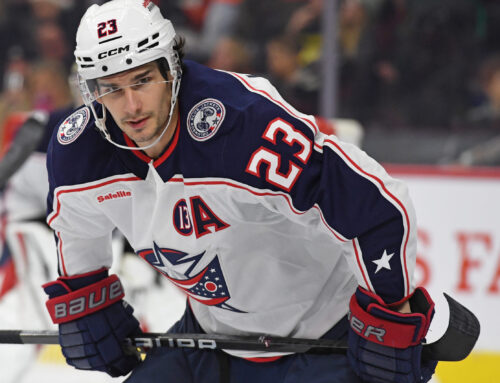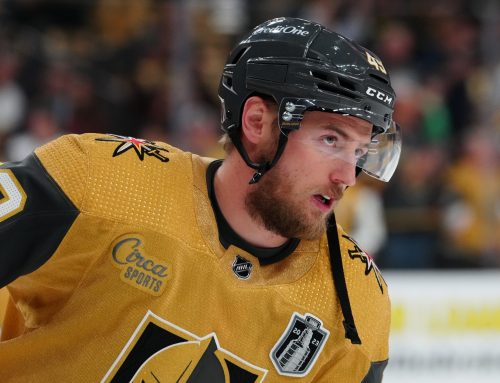With Seattle on the brain, we turn to expansion teams. This will be a bit less about Seattle's current draft list (which is likely to change before opening night) and more about doing a little expectation setting. We will start by digging into our last example of an expansion team entering into the league and see what we can learn from their inaugural season. We are going to focus this article on the top six forwards to try and determine what impacts the move had for those players.
This week on Frozen Tools Forensics: Looking Back To Look Forward
As per usual we are going to start with a note on process. Frozen Tools has an incredibly useful feature for pulling together players for review. I am talking of course about the Compare Player feature. When you pull up the Frozen Tools home page, and open the Players drop down menu you can access the Compare Players function. This reporting format lets you type in the specific players you are looking for (say Jonathan Marchessault, William Karlsson, and Reilly Smith for example). You select the time frame and can view their data side by side. In this case we are looking at their 2016-17 seasons, and then Vegas' inaugural 17-18 season for comparison. The report gives two different tables, one for Basic Stats, and one for Expanded Stats. For the purposes of our article I copied both tables out and then selected the stat categories I most wanted to compare. These formed the tables we will be looking at below.
| 2016-17 | GP | G | A | PTS | SH% | PTS/G | PTS/60 | SOG/G | SOG/60 | EVTOI | PPTOI | %PP |
| WILLIAM KARLSSON | 81 | 6 | 19 | 25 | 6.3 | 0.31 | 1.4 | 1.2 | 5.3 | 11:33 | 0:12 | 4.7 |
| JONATHAN MARCHESSAULT | 75 | 30 | 21 | 51 | 15.7 | 0.68 | 2.4 | 2.5 | 9.1 | 13:58 | 2:41 | 47.7 |
| REILLY SMITH | 80 | 15 | 21 | 36 | 9.4 | 0.45 | 1.5 | 2 | 6.6 | 14:04: | 2:24 | 43.6 |
In 16-17 our future top line in Vegas was a bit underwhelming. Marchessault was clearly the most productive with a 56ish full season pace. He had the highest shot rates and the most power-play time. Both he and Smith were getting some reasonable (if not at all exciting) middle six even strength minutes and second power-play time. Kalsson was scraping the bottom of the barrel in deployment with poor shot rates, low even strength time, and no power-play time. Even his per 60 numbers were not all that exciting, which could have been an early indication that he would produce if given a better opportunity.
| 2017-18 (VGK) | GP | G | A | PTS | SH% | PTS/G | PTS/60 | SOG/G | SOG/60 | EVTOI | PPTOI | %PP | IPP |
| WILLIAM KARLSSON | 82 | 43 | 35 | 78 | 23.4 | 0.95 | 3 | 2.2 | 7.2 | 14:39 | 2:24 | 47.6 | 70.3 |
| JONATHAN MARCHESSAULT | 77 | 27 | 48 | 75 | 10.1 | 0.97 | 3.3 | 3.5 | 11.9 | 15:01 | 2:28 | 49.4 | 72.1 |
| REILLY SMITH | 67 | 22 | 38 | 60 | 13.6 | 0.9 | 3 | 2.4 | 8.1 | 13:54 | 2:22 | 46 | 69.8 |
Fast forward to 2017-18 and a lot changed, though quite frankly, not exactly in the way I expected. We know that this top line took the league by storm, and just looking at the point differentials it isn't really hard to see why. Karlsson jumped 53 points and all of them improved their total points, PTS/G, PTS/60, SOG/G, and SOG/60 numbers. As we will see in a moment that is actually true for all of the top six in Vegas. The answer then seems to be – take players who were bottom/middle six players, give them primary roles and opportunity and watch them shine. To some extent that is true, but let's look a little closer.
The following table is the change we see between the two years for players. It includes the top line we have already been looking at, but also the second like of Erik Haula, James Neal, and David Perron (side note – how many of those players would you have named if I asked you who the second line for Vegas was in their first season?).
If we take the first column of shooting percentage: Karlsson's 17.1 percent means that during his first year in Vegas he shot 17.1 percent higher than in his prior year, while Marchessault shot 5.6 percent worse.
| SH% | PTS/G | PTS/60 | SOG/G | SOG/60 | EVTOI | PPTOI | %PP | IPP | |
| WILLIAM KARLSSON | 17.1 | 0.64 | 1.6 | 1 | 1.9 | 3:06 | 2:12 | 42.9 | 12.2 |
| JONATHAN MARCHESSAULT | -5.6 | 0.29 | 0.9 | 1 | 2.8 | 1:02 | -0:13 | 1.7 | -4 |
| REILLY SMITH | 4.2 | 0.45 | 1.5 | 0.4 | 1.5 | -0:10 | -0:02 | 2.4 | 9.8 |
| ERIK HAULA | 5.4 | 0.36 | 0.9 | 0.4 | -0.1 | 0:58 | 2:11 | 45 | 4.4 |
| JAMES NEAL | 1 | 0.03 | 0.2 | -0.1 | 0.1 | 0:11 | 0:18 | -4.4 | -6.4 |
| DAVID PERRON | 0.9 | 0.38 | 1.3 | 0 | -0.4 | 1:03 | 0:25 | 6.4 | 11.2 |
Each one of the above players saw increases in their goal totals (except Perron actually – he dropped by two), assist totals, point totals, and shot toals. All also increased their PTS/G and PTS/60 rates (unsurprisingly). The theory goes that all of this point scoring came because of 'increased opportunity'. Karlsson is actually the only player on the list though that saw a big tick up at even strength. Marchessault, Haula, and Perron all saw a bit of a modest increase from something like 13-14 minutes or 14-15 minutes, but Karlsson is the only really big winner here. It is even more dramatic on the power-play. Haula and Karlsson saw meaningful increases but everyone else saw pretty marginal changes and Smith and Marchessault even saw small decreases in their total power-play time.
Even with the increases no one saw more than 19 minutes a night on average, or more than three minutes a night on the power-play. It is pretty unusual for a player to score at a point-per-game rate without that deployment. Both Marchessault and Karlsson were close, but there was actually only one player (Auston Matthews) who managed it in 2017-18 and three who pulled it off in 2021 (David Perron, Max Pacioretty, and Roope Hintz). In all of the above cases though the players played less than 62 games in the season. That reduced game count definitely helped them maintain their point-per-game pace.
What our time on ice measure doesn't capture though is the quality of that time. Clearly something changed for Marchessault (for example). His shooting percentage went down, his points participation rate (IPP) went down, his power-play time went down, but he was shooting more, and scoring more per 60 than in the prior year. As it happened a lot of that had to do with the success his linemates were having while he was on the ice. His linemates, Karlsson with his 23.5 shooting percentage, and even Smith, were scoring at an unexpectedly high rate which led to Marchessault pointing more than expected.
All of this means that unfortunately the big years we saw from Vegas players almost across the board was a great story line, but not ultimately unsustainable. If Karlsson shot at his usual 13ish percent he would have dropped about 18 goals to about a 60-ish-point pace. While it is not a perfect comparison as the line has settled into a 1b/ Line 2 role – with a few additional years of data, and the benefit of hindsight it looks like the move transformed Marchessault from a 50- to a 60-point player, Karlsson from a 25- to a 60-point player, and Smith from a 45-point to a 55-point potential player. This framing is actually consistent with the above data. Karlsson, seeing the biggest jump in deployment (both at even strength and on the power-play) is a transformed player (this was briefly true for Haula as well, but injuries and moving teams has changed him yet again). Marchessault and Smith are improved players, though perhaps not dramatically.
So what do we do with all of this? With all of the excitement here about a new team and new opportunity just remember that all of that found value in Vegas was a bit of a mirage. Without those wild swings in fortune (which I suppose could happen – but we certainly can't count on them this time around) we were looking at a top line of three 60ish point Vegas forwards year one. Improved player performances? Yup. Valuable to Vegas? Definitely. Worth the potential hype and draft cost this year? Maybe not.
That's all for now. Stay safe out there.
Help make hockey accessible for everyone. Start by supporting:





 FLA
FLA CHI
CHI NYR
NYR PIT
PIT L.A
L.A COL
COL UTA
UTA BOS
BOS BUF
BUF SEA
SEA NYI
NYI VAN
VAN TOR
TOR CBJ
CBJ DET
DET ARI
ARI
